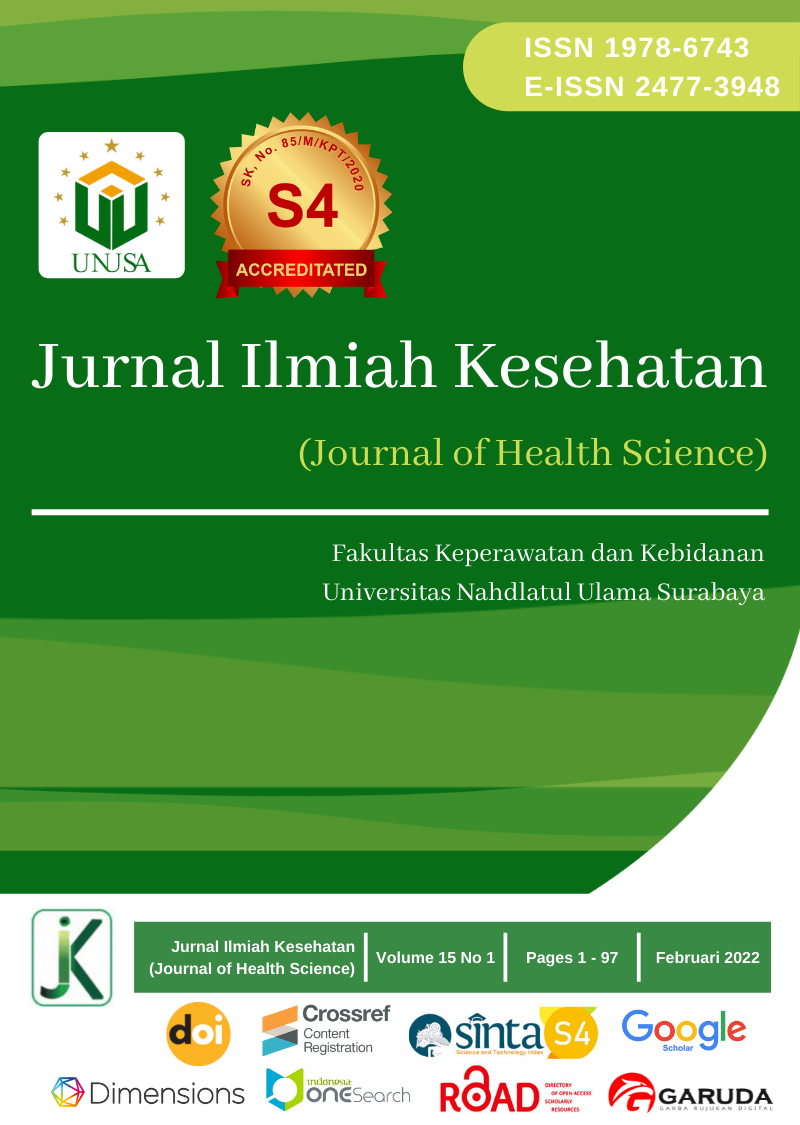The Potential of Home-based Cardiac Rehabilitation Via Telehealth in Patients with the Post- Acute Coronary Syndrome in Indonesia: A Literature Review Study
Main Article Content
Abstract
Patients with post-acute coronary syndrome (ACS) require cardiac rehabilitation.
However, there were obstacles in in-hospital cardiac rehabilitation (IHCR), so that it
impacts on recurrence and a decreased quality of life. This paper analyzes the potential
of home-based cardiac rehabilitation (HBCR) via Telehealth in post-ACS patients in
Indonesia. It was a literature review study. We used articles from electronic media
through the keywords home-based cardiac rehabilitation, Telehealth, and acute coronary
syndrome. Journals were obtained through search sites on Google Scholar, Science
Direct, PubMed, and ProQuest. The identification criteria were using Indonesian and
English with the year of publication from 2015 to 2020. Then, we analysed and
synthesized eligible publications using the PRISMA method. Findings from eight
journals showed that the most common barriers for patients in in-hospital cardiac
rehabilitation were logistical barriers (distance, time, functional status) and the patient's
insufficient knowledge regarding the importance of cardiac rehabilitation. HBCR is an
implementation model that has the potential as an effective solution in overcoming
logistical limitations between patients and doctors. Care providers in several developed
countries have implemented HBCR. It significantly improved medication adherence,
outcome, and safety profile in patients. Furthermore, virtual cardiac rehabilitation
provided the same outcome and safety profile as IHCR. Indonesia needs to develop
HBCR via Telehealth for secondary prevention management in patients after heart
events, especially ACS. Developing Telehealth could reduce complications and
recurrence, improve lifestyle and physical
Downloads
Article Details
Copyright (c) 2022 Lutfian, Nur Rohmawati, Nila Uli Saadah

This work is licensed under a Creative Commons Attribution-ShareAlike 4.0 International License.
References
Asosiasi Penyelenggara Jasa Internet Indonesia. (2017). Penetrasi & Perilaku Pengguna Internet Indonesia 2017. Penetrasi Dan Perilaku Pengguna Internet Indonesia, 1–39.
Chan, P. S., Jones, P. G., Arnold, S. A., & Spertus, J. A. (2014). Development and validation of a short version of the seattle angina questionnaire. Circulation: Cardiovascular Quality and Outcomes, 7(5), 640–647. https://doi.org/10.1161/CIRCOUTCOMES.114.000967
Drwal, K, D., Forman, B., Wakefield et al. 2020. Cardiac Rehabilitation during COVID-19 Pandemic: Highlighting the Value of Home-Based Programs. Telemedicine and e-health Journal. 26(11). 1322-1324. https://doi.org/10.1089/tmj.2020.0213
Kementerian Kesehatan. (2018). Hasil Utama Riskesdas 2018.
Moradkhani, A., & Baraz, S. (2018). Effects of Local Thermotherapy on Chest Pain in Patients with Acute Coronary Syndrome : A Clinical Trial. Jundishapur Journal of Chronic Disease Care, 7(4). https://doi.org/10.5812/jjcdc.69799.Research
Moulson, N, D., Bewick, T., Selway et al. 2020. Training/Practice Contemporary Issues in Cardiology Practice Cardiac Rehabilitation During the COVID-19 Era: Guidance on Implementing Virtual Care. Canadian Journal of Cardiology.
Muller, C. J., Noonan, C. J., MacLehose, R. F., Stoner, J. A., Lee, E. T., Best, L. G., Calhoun, D., Jolly, S. E., Devereux, R. B., & Howard, B. V. (2019). Trends in Cardiovascular Disease Morbidity and Mortality in American Indians Over 25 Years: The Strong Heart Study. Journal of the American Heart Association, 8(21), 1–12. https://doi.org/10.1161/JAHA.119.012289
Nuraeni, A. (2016). Faktor yang Memengaruhi Kualitas Hidup Pasien dengan Penyakit Jantung Koroner. Jurnal Keperawatan Padjadjaran, v4(n2), 107–116. https://doi.org/10.24198/jkp.v4n2.1
Pramadiaz, A. T., Fadil, M., & Mulyani, H. (2014). Hubungan Faktor Risiko Terhadap Kejadian Sindroma Koroner Akut pada Pasien Dewasa Muda di RSUP Dr . M . Djamil Padang. Jurnal Kesehatan Andalas, 5(2), 330–337.
Quiles, J., & Miralles-vicedo, B. (2014). Secondary Prevention Strategies for Acute Coronary Syndrome. 67(10), 844–848.
Ricci, B., Cenko, E., Vasiljevic, Z., Stankovic, G., Kedev, S., Kalpak, O., Vavlukis, M., Zdravkovic, M., Hinic, S., Milicic, D., Manfrini, O., Badimon, L., & Bugiardini, R. (2017). Acute coronary syndrome: The risk to young women. Journal of the American Heart Association, 6(12), 1–12. https://doi.org/10.1161/JAHA.117.007519
Roberts, C. R., Wofford, J. E., Hoy, H. M., & Faddis, M. N. (2016). Implementation of a screening program for patients at risk for posttraumatic stress disorder. Clinical Medicine Insights: Cardiology, 10, 129–137. https://doi.org/10.4137/CMC.S39957
Saripudin, N. F., Emaliyawati, E., & Somantri, I. (2018). Hambatan Pasien Penyakit Jantung Koroner (PJK) Untuk Menjalani Rehabilitasi Jantung. Jurnal Perawat Indonesia, 2(1), 20. https://doi.org/10.32584/jpi.v2i1.37
Smolderen, K. G. (2017). Coping after an Acute Myocardial Infarction: The Role of Depression and Anxiety. American College of Cardiology, 1–5.
Sunjaya, A. P., Sunjaya, A. F., & Priyana, A. (2019). Insights and challenges of indonesia ’ s acute coronary syndrome telecardiology network : three year experience from a single center and in west Jakarta , Indonesia Insights and challenges of indonesia ’ s acute coronary syndrome telecardiology network : (No. 508; (2019) 012142). https://doi.org/10.1088/1757-899X/508/1/012142
Thomas, R., Beatty, A, T., Beckie et al. 2019. Home-Based Cardiac Rehabilitation: A Scientific Statement From the American Association of Cardiovascular and Pulmonary Rehabilitation, the American Heart Association, and the American College of Cardiology. Journal of the American College of Cardiology 74 (1). 133-153. https://doi.org/10.1016/j.jacc.2019.03.008
Tulloch, H., Greenman, P. S., & Tassé, V. (2015). Post-traumatic stress disorder among cardiac patients: Prevalence, risk factors, and considerations for assessment and treatment. Behavioral Sciences, 5(1), 27–40. https://doi.org/10.3390/bs5010027
Wahid, A., Risiko, F., & Koroner, S. (2019). Karakteristik Pasien Sindrom Koroner Akut Pada Pasien Rawat Inap Ruang Tulip DI RSUD Ulin Banjarmasin. Indonesian Journal for Health Sciences, 3(1), 6–12.
Wakefield, K, B., Draql, M., Paez et al. 2019. Creating and disseminating a home-based cardiac rehabilitation program: Experience from the Veterans Health Administration. BMC Cardiovascular Disorders 19 (1). 1-7. https://doi.org/10.1186/s12872-019-1224-y
Wolf, A., Fors, A., Ulin, K., Thorn, J., Swedberg, K., & Ekman, I. (2016). An eHealth diary and symptom-tracking tool combined with person-centered care for improving self-efficacy after a diagnosis of acute coronary syndrome: A substudy of a randomized controlled trial. Journal of Medical Internet Research, 18(2). https://doi.org/10.2196/jmir.4890





